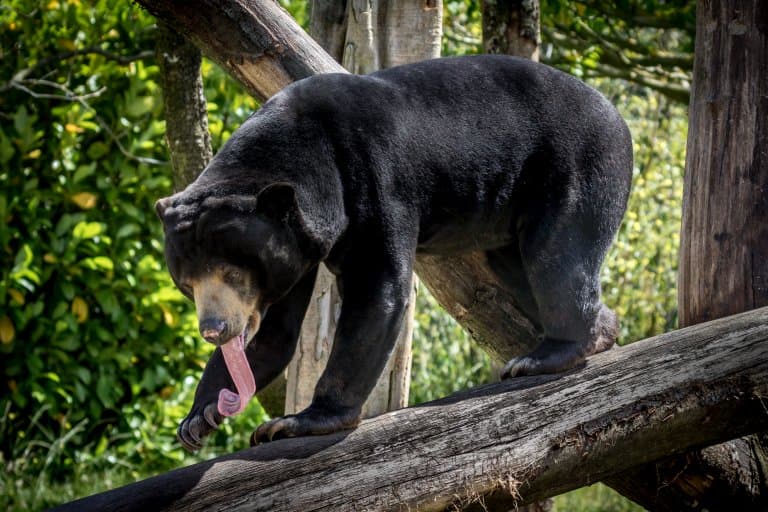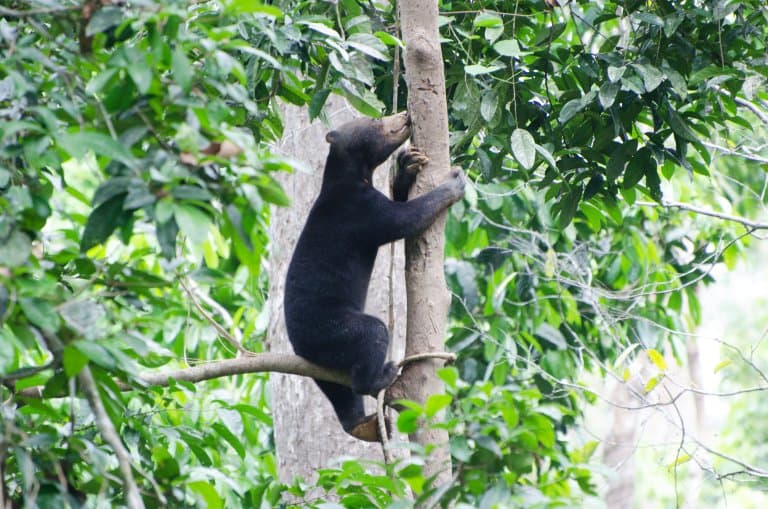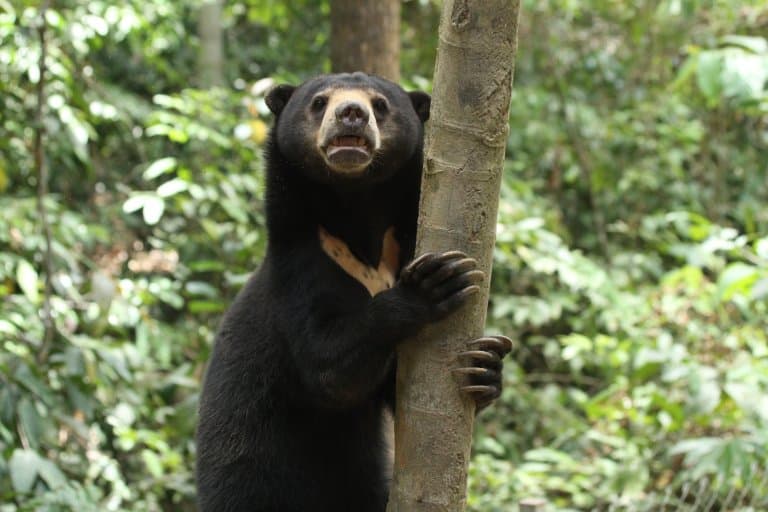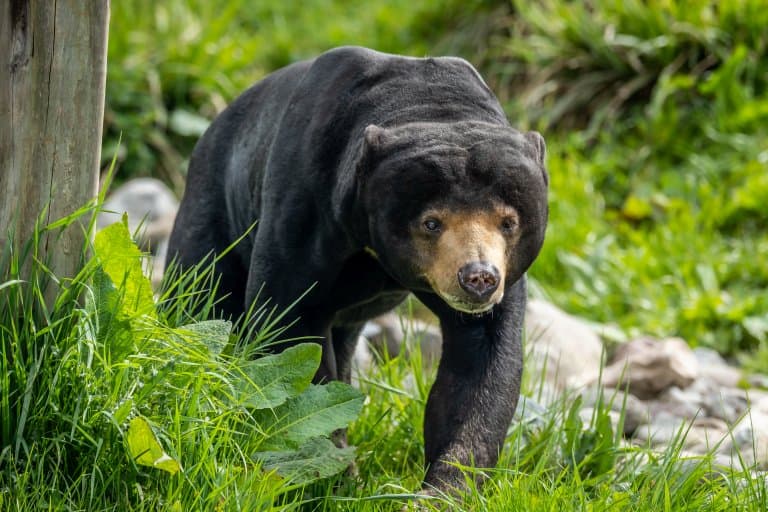Sun Bear Profile
The sun bear is the smallest of all bears standing at just 70cm tall, and is also known as the honey bear. The cream coloured patch on their chests helps give them their common name, as many people think they look like a rising sun. They are usually dark black in colour, with a lighter snout.
Sun bears are expert climbers and can utilise a variety of food sources as omnivores. They have a real liking for honey and use their long, sharp claws to help extract it from bee hives high up in trees.
They are found across South East Asia, usually in dense, tropical rainforests, evergreen and montane forests.

Sun Bear Facts Overview
| Habitat: | Tropical forests |
| Location: | South East Asia |
| Lifespan: | Up to 25 years in the wild |
| Size: | 1.2–1.5 metres long |
| Weight: | 35-80 kg (77 – 175 lbs) |
| Color: | Generally black but can range from grey to red with a white/cream/orange patch on their chests |
| Diet: | Insects, plant material, seeds, fruit, small rodents |
| Predators: | Pythons, leopards, tigers, dholes |
| Top Speed: | 48 kph (30 mph) |
| No. of Species: |
1 species, with 2 subspecies |
| Conservation Status: |
Vulnerable |
Sun bears range from India, to Cambodia, Myanmar, Laos, Thailand, Vietnam, Malaysia and Indonesia. They used to be found in more lowland habitats, however because of logging and other activities that reduce the size of these areas, their numbers have reduced significantly.
Males are generally slightly larger than females (10-20% bigger) with both being roughly the size of a large dog. They have a muscular, thickset build with a relatively short snout, small ears and large claws. All these attributes make them exceptional climbers. They also have fairly short but thick fur which helps stop them from getting too hot but also gives them protection from things such as branches when climbing in trees.
Sun bears have mainly been observed as diurnal, carrying out most of their feeding activities during the day. However some have been observed foraging at night. This is especially prevalent in areas close to human inhabitation.
Sun bears eat a variety of foodstuffs including ants, bees, honey, rodents, lizards, berries, fruit, seeds, roots/tubers and many other types of insect. They use their keen sense of smell to help detect their food and their long claws to help extract it. Their claws are particularly useful when trying to excavate termites from a mound.
Their tongues also appear extremely long and this helps when licking/eating up insects or extracting honey from a hive (they can also eat the bees, too).
These bears are seen to be fairly solitary animals, only coming together to mate or when a female is looking after her cubs. Some studies also suggest that sun bears do create monogamous pairs.
Sun bears do not have a specific breeding season and females (sows) will usually breed after 3-4 years of age and give birth usually to one or two young. Before she gives birth to her cubs she will build a nest on the ground where she will give birth. The cub’s senses are not developed at first and they will remain in their nests until these are more advanced and they can also walk and climb.
Sun bears have been observed using a small number of vocalisations. They snort and grumble when foraging and digging for food and make louder raucous calls during the mating season to alert each other of their presence. They also show behaviours like head bobbing, hugging and mock fighting when they do find a mate.
They are one of the rarest bears on earth and are listed as vulnerable by the IUCN. Their low numbers in the wild are in part linked to habitat destruction and therefore having to live in relatively isolated patches of forest.
Interesting Sun Bear Facts
1. Sun Bears are the smallest bear species
The sun bear’s relatively small stature helps it spend most of its time in trees, whether this is for foraging or resting.

2. They are well adapted to climb
As well as their small size, sun bears have many adaptations for a more arboreal life. Their large, sickle shaped, strong claws help them grip. Also their paws lack fur which helps them grasp bark when climbing.
Their hind limbs also have been observed to be developed in a way that makes them more skilful at climbing trees (similar to the giant panda). 1

3. Sun bears do not hibernate
It is thought that they do not hibernate, as in the ranges they occupy food is generally available all year round.
4. Parts of their bodies are used in traditional medicine
One of the largest threats to the sun bear is people using some of their body parts in traditional medicines.
Bile from their gall bladders and the gall bladder itself are used. Sun bears are also farmed for these types of body part.
Paws, teeth and claws are also sold and poachers often kill them to sell through the bush meat trade. 2
5. They are sold as pets
Evidence has showed that live sun bear cubs are bought through illegal pet trading.
People believe these bears, as they are small, aren’t aggressive so will make a good pet. To take away cubs from their mother, the mother will most likely be killed in the process.
6. Sun bears tongues can grow up to 30cm in length!
Which compared to their body size, seems disproportionally long (twice as long as a human tongue).
They use them to extract termites/ants/larvae from mounds/wood/soil and also honey and the comb from beehives.

7. They can mimic each other’s facial expressions
Some studies (mainly looking at sun bears residing in the Bornean Sun Bear Conservation Centre) have shown that sun bears can copy, or mimic, each other’s facial expressions.
Previously it was thought that only animals living in more complex social groups, such as primates and dogs, show this type of behaviour – but sun bears have been seen to change their mouth/lip/teeth position in response to each other.
Some researchers believe this could be linked to their more captive setting. 3
8. They sleep in trees at night
Sun bears will build a nest like structure in trees and often sleep in them at night. They also use tree cavities and hollows to rest in.
9. Sun bears can cradle their young
Some sun bear mothers have been seen to stand on their hind legs and hold their young in their arms, in a cradling position.
10. Sun bears have strong teeth
These bears have large canine teeth and studies have also shown a strong bite force for its size.
This isn’t well understood, but it is thought that it could be related to having to open up trees with a hard outer bark to reach insects and other similar food sources.

11. They have big cat predators
There is relatively little data linked to what predates on sun bears. However using camera traps, leopards have been observed eating sun bear cubs. Tigers are also thought to predate on them as well as dholes in some areas.
A case of a reticulated python eating an adult female sun bear has also been reported, however it was thought that the mother was weakened by feeding cubs and predated upon during the hours of darkness. 4 5
12. They are important for dispersing seeds
Some studies have shown that sun bears in certain areas have many different seed types in their faeces. As they move around, they disperse these and help plants spread.
13. Sun bear populations are vulnerable
Because of their decreasing habitat size, due mainly to deforestation, sun bears are encroaching into areas occupied by humans.
Farmers will often kill sun bears as they raid crops such as coconuts, bananas and oil palm.
Sadly due to this, as well as illegal hunting and the wildlife trade, their populations have declined by 35% over the past three decades.

14. Sadly populations are predicted to decline by 50-80% in Vietnam
This is over the next 30 years due to habitat loss, hunting and the pet trade.
The sun bear is listed as vulnerable by the ICUN, and with the exception of Malaysia and Cambodia, the sun bear is legally protected from hunting.
Sun Bear Fact-File Summary
Scientific Classification
| Kingdom: | Animalia |
| Phylum: | Chordata |
| Class: | Mammalia |
| Order: | Carnivora |
| Family: | Ursidae |
| Subfamily: | Ursinae |
| Genus: | Helarctos |
| Species Name: |
Helarctos Malayanus |
Fact Sources & References
- Motoki Sasaki (2005), “Adaptation of the hindlimbs for climbing in bears“, National Library of Medicine.
- “Sun Bear“, WWF.
- Jake Buehler (2019), “These bears mimic each other’s faces as well as people do“, National Geographic.
- Hla Naing (2020), “Large carnivores as potential predators of sun bears“, Research Gate.
- Gabriella Margit Fredriksson (2005), “Predation on sun bears by reticulated python in East Kalimantan, Indonesian Borneo“, Research Gate.
